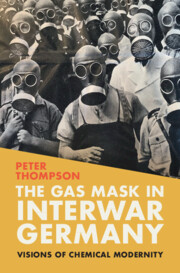Book contents
- The Gas Mask in Interwar Germany
- Science in History
- The Gas Mask in Interwar Germany
- Copyright page
- Dedication
- Contents
- Figures
- Tables
- Acknowledgments
- Abbreviations
- Introduction
- 1 The Structures of Violence: Fritz Haber and the Institutionalization of Gas Warfare
- 2 The Man in the Rubber Mask: World War I and the Development of the Modern Gas Mask
- 3 The First “Chemical Subjects”: Soldier Encounters with the Gas Mask in World War I
- 4 The Limits of Sympathy: The Medical Treatment of Poison Gas during and after World War I
- 5 Atmos(fears): The Poison Gas Debates in the Weimar Republic
- 6 Technologies of Fate: Cultural and Intellectual Prophesies of the Future Gas War
- 7 Synthesizing the “Nazi Chemical Subject”: Gas Masks, Personal Armoring, and Vestiary Discipline in the Third Reich
- 8 Prophets of Poison: Industrialized Murder in the Gas Chambers of the Holocaust
- Conclusion
- Bibliography
- Index
1 - The Structures of Violence: Fritz Haber and the Institutionalization of Gas Warfare
Published online by Cambridge University Press: 11 May 2023
- The Gas Mask in Interwar Germany
- Science in History
- The Gas Mask in Interwar Germany
- Copyright page
- Dedication
- Contents
- Figures
- Tables
- Acknowledgments
- Abbreviations
- Introduction
- 1 The Structures of Violence: Fritz Haber and the Institutionalization of Gas Warfare
- 2 The Man in the Rubber Mask: World War I and the Development of the Modern Gas Mask
- 3 The First “Chemical Subjects”: Soldier Encounters with the Gas Mask in World War I
- 4 The Limits of Sympathy: The Medical Treatment of Poison Gas during and after World War I
- 5 Atmos(fears): The Poison Gas Debates in the Weimar Republic
- 6 Technologies of Fate: Cultural and Intellectual Prophesies of the Future Gas War
- 7 Synthesizing the “Nazi Chemical Subject”: Gas Masks, Personal Armoring, and Vestiary Discipline in the Third Reich
- 8 Prophets of Poison: Industrialized Murder in the Gas Chambers of the Holocaust
- Conclusion
- Bibliography
- Index
Summary
By bridging the world of academic chemistry and the major German chemical companies, the chemist Fritz Haber was able to effectively deliver chemical weapons to the German military over the course of World War I. While the first German chlorine gas attack at the Second Battle of Ypres on April 22, 1915, is often described as the commencement of the chemical war and a major breach in the international rules of warfare, it can also be productively viewed as a merging of academic science and industrial chemistry into the bureaucratic structures of the German military. Thus, Fritz Haber’s Kaiser Wilhelm Institute for Physical and Electrochemistry, the major site of German chemical weapons research, should be read as an early blueprint for later historical developments in Big Science and the military-industrial-academic complex.
Keywords
- Type
- Chapter
- Information
- The Gas Mask in Interwar GermanyVisions of Chemical Modernity, pp. 14 - 53Publisher: Cambridge University PressPrint publication year: 2023

